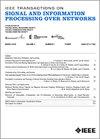Two-View and Multi-View Tensor Canonical Correlation Analysis Over Graphs
IF 3
3区 计算机科学
Q2 ENGINEERING, ELECTRICAL & ELECTRONIC
IEEE Transactions on Signal and Information Processing over Networks
Pub Date : 2025-01-29
DOI:10.1109/TSIPN.2025.3536102
引用次数: 0
Abstract
In this work, we focus on the multi-view dimensionality reduction problem for tensor data on graphs. In particular, we extend canonical correlation analysis on graphs图上的二视图和多视图张量典型相关分析
本文主要研究图上张量数据的多视图降维问题。特别地,我们扩展了图上典型相关分析(CCA-G)和多视图图上典型相关分析(MCCA-G)用于张量数据。直接将CCA-G和MCCA-G应用于张量数据需要向量化,这破坏了数据的底层结构,往往会输出非常高维的数据,导致维度的诅咒。为了避免矢量化操作,我们提出了双视图数据的张量典型相关分析(TCCA-G)和多视图张量数据的张量多视图典型相关分析(TMCCA-G),以保留数据的内在结构并考虑潜在变量中的潜在图结构。特别是,提出的TCCA-G提高了图上张量正则变量的平滑性,并输出集内相关和集间不相关的张量正则变量。在缺乏潜在变量的先验(平滑)信息的情况下,TCCA- g简化为张量典型相关分析(TCCA),仅保留数据的内在结构并产生一组不相关的特征。为了求解TCCA- g和TCCA,我们提出了一种基于交替最小化的算法。特别地,通过求解特征值问题得到了TCCA和TCCA- g中的正则子空间。TMCCA-G将TMCCA-G扩展到多视图数据,其中TMCCA-G通过求解简单的最小二乘问题获得正则子空间,并使用类似crank - nicolson的更新递归获得公共源,以保持正交性约束。在没有图先验的情况下,我们提出了张量多视图典型相关分析(TMCCA),其中通过求解正交Procustes问题以封闭形式获得公共源。因此,与TMCCA- g相比,TMCCA中的每个子问题都有一个封闭的解。我们通过对真实数据集的分类和聚类等不同任务的实验证明了所提出算法的有效性。
本文章由计算机程序翻译,如有差异,请以英文原文为准。
求助全文
约1分钟内获得全文
求助全文
来源期刊

IEEE Transactions on Signal and Information Processing over Networks
Computer Science-Computer Networks and Communications
CiteScore
5.80
自引率
12.50%
发文量
56
期刊介绍:
The IEEE Transactions on Signal and Information Processing over Networks publishes high-quality papers that extend the classical notions of processing of signals defined over vector spaces (e.g. time and space) to processing of signals and information (data) defined over networks, potentially dynamically varying. In signal processing over networks, the topology of the network may define structural relationships in the data, or may constrain processing of the data. Topics include distributed algorithms for filtering, detection, estimation, adaptation and learning, model selection, data fusion, and diffusion or evolution of information over such networks, and applications of distributed signal processing.
 求助内容:
求助内容: 应助结果提醒方式:
应助结果提醒方式:


